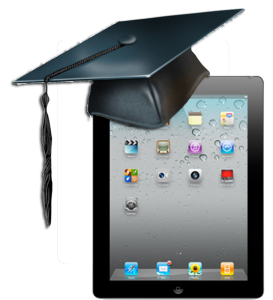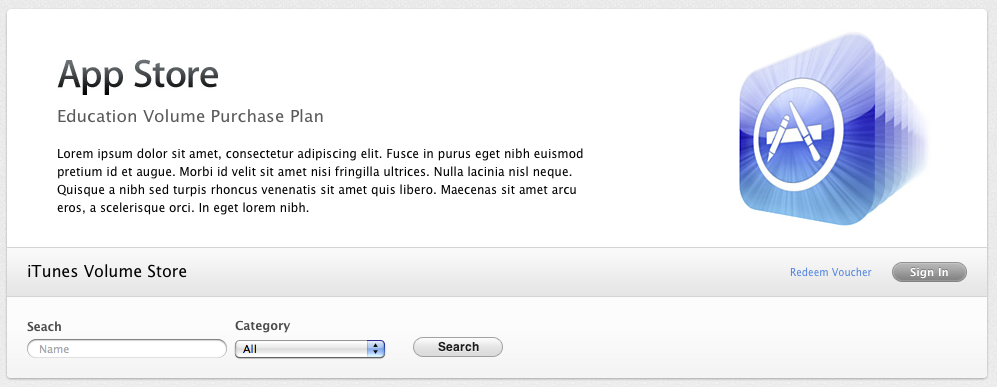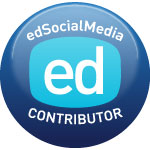 In an earlier post (The iPad in Education and the Questions – 1/10/2011) I began to look at how an iPad could be used in school in a 1:1 setting. When I wrote the post, I had a lot of question. Some have been answered; many have not. I’m beginning to understand the market for the iPad and have a few observations.
In an earlier post (The iPad in Education and the Questions – 1/10/2011) I began to look at how an iPad could be used in school in a 1:1 setting. When I wrote the post, I had a lot of question. Some have been answered; many have not. I’m beginning to understand the market for the iPad and have a few observations.
Schools and educator need to first realize one thing as I did… the iPad is a consumer product. Period. The way in which Apple is marketing the device and building out the iOS it’s clear that they have the individual consumer in mind. For instance, the lack of multiple users in iOS which is something education would benefit from. Not even the about-to-be-released iOS 5 will have support for multiple users and there seems to be no interest in making the iPad easier to use by multiple users (sell more iPads). Those looking to deploy iPads in a 1:1 setting need to keep this fact in mind when planning their deployments.
It also begs the question… “Who owns the iPad and are apps now consumable items?”
What I mean by this is depending on your model for deployment the question and idea of device ownership, the app(s) and what the end-user can do becomes important.
In any deployment model, settings can be configured to individualized the iPad to meet a user’s needs. Mail, calendaring, appearance settings and user-based applications (Evernote, GoodReader, etc) can be configured so that each person’s iPad is there own. Providing this kind of ownership and customization on a device, I believe, is crucial its successful adoption and welcomed use in any 1:1 device program.
If you are deploying a large fleet of iPads, you’ll want your constituents to take ownership of that device and the learning you hope to encourage through its use. You’ll want them to grow as independent and autonomous learners through exploration and discovery. By engendering a feeling of ownership in the iPad (or any school issued device) it affects the treatment of the device.If a user is allowed to have both their schoolwork and their pictures, music and apps on the device they are more likely to treat that device with more care than something they feel is not truly theirs to begin with.
As I see it there are three possible methods for deploying an iPad and the apps:
- Centralized Account Syncing – A traditional model
- Tandem Accounts – A blended model
- Individual Accounts – User “owned“
Centralized Account Syncing
This is the most traditional of models and one that those deploying iPad carts would be most likely to use. All of the iPads have a single Apple ID and sync to a single machine or account. For a user to install a new application on the iPad they would have to sync the iPad with the account or know the Apple ID password to download the application from the App Store.
This model makes the ownership of the device firmly in the hands of the institution issuing the iPad. The user had no ability to add apps or sync to another device (desktop or laptop) to move pictures, music or other items. The school maintains ownership of all of the apps.
Tandem Accounts
In this model the iPad would be configured with a base set of apps that would be installed from a single Apple ID and then distributed to the users. Once in the hands of the user they would be able to change the Apple ID to their own and download and install their own apps, purchase music or books.
They would not however be able to sync to another device as syncing would cause any of the apps installed using the school’s Apple ID to be removed from the device and only those apps purchased by the individual would remain.
This model provides more ownership in the device than the centralized syncing model, but it still presents many hurdles in giving the end-user a real feeling of ownership as well as making it difficult for schools to distribute new apps after the initial deployment.
Individual Accounts
Ownership is in the hands of the individual. When iPads are deployed in this model the user has control over the device. Each person would need to download and install each app on their own iPad through a mobile device management (MDM) platform (JAMF Casper, Airwatch, Absolute Software, MobileIron – we use JAMF) using a redemption voucher or code purchased through the Apple Volume Purchasing program (more below).
In this model the user would retain ownership of the apps as they would be downloaded and install using the individual’s Apple ID. Schools deploying in this way would need to budget for these applications much in the same way they do for any consumable items as when the iPad is returned to the school the apps remain with the individuals account, not the school’s.
Regardless of the model you choose, there are ways in which schools can manage the iPads in their institutions. Through MDM applications, Apple’s iPhone Configuration Utility and other network based tools schools can share ownership and control in the device with the user.
Apple Volume Purchasing Program
With any model you choose, your school need a way to purchase apps in quantity. The way to do this is via the Apple Store Volume Purchase Program (VPP)
Educational institutions (US only at the moment) can enroll in the program and receive tax-exempt, discounted purchasing and use PO’s for ordering. Each institution would need to then identify a program facilitator who can them shop at a special store (https://volume.itunes.apple.com/us/store). The school would be supplied with a spreadsheet containing the redemption codes which would then be distributed to the users individually or though their MDM platform.
App deployment is still in its infancy (as represented by the body copy leading into the store – see image above) and schools and Apple seem to be trying to figure things out as they go.
An Additional Consideration – Disaster Recovery (Thanks Fraser Speirs – @fraserspeirs)
Regardless of what model you choose, be sure to consider a disaster recover strategy. If you are not allowing your users to sync to another device (desktop or laptop) you will need to think about how to leverage tools like Evernote or DropBox. Once iCloud is available this will provide an additional option, however it will also add another level of management.
The rapid growth of the iPad in the education market has everyone rethinking how they are doing things. Traditional methods of purchasing and deployment are getting turn on their head and new models are being developed on a daily basis. While the iOS expands and new features like the ability to move downloaded apps purchased on one device to another sharing the same Apple ID or with the upcoming release of iOS 5 and iCloud we can all only wait and see what we will be presented with next and how we will need to evolve.
How are you either thinking about or actually managing your iPad deployments? Please take a moment and share something in a comment below.
NOTE: I’ve posted some information on this topic to the ISED listserv. You can read some of the comments on that thread here.
[Special thanks to Damien Barrett – @damienbarrett – for his help with this post]




Pingback: The iPad in Education and the Questions | williamstites.net
Thanks a lot for your insight Bill! We are moving in this direction at my school and I am glad to have heard your thoughts. The administration is still wants to look into other options for tablets. Are you sure the iPad will be the best tablet for education in the future?
I wish I had a crystal ball and could predict that, but I have to say that the iPad have a very early lead in this area. With other similar device coming and going I would be hard pressed to go in a different direction.
The word “tablet” though I think is confusing as if you were to say that word to me a year or two ago I would have thought of a PC -based computer where you had a keyboard and a screen you can write on. Thew iPad and even Android-based device are not, to me, tablet based device by this definition and it’s word that need to be either redefined or changed.
Nicely put … thanks for sharing.
I’ve linked to the post at http://www.shambles.net/pages/learning/ict/1to1laptop/ which is a subsection of a larger mobile area at http://www.shambles.net/ict/#mobile
I’ve changed my own opinion on tablets/iPads being simply consumer devices … I do not agree anymore … for example I was in a rice field last month just with my iPad2 … I shot a video … edited it .. and uploaded to YouTube without leaving the field … see http://youtu.be/GUxwxQm0Jr8
I also did do a longer version but waited until I was indoors … it was hot outside …. see http://youtu.be/LziQnWRPZEA … still ALL done on the iPad.
——————————-
Bill, we’re planning a “bring-your-own” model for the new high school project I’m working on. We don’t intend for 1:1 devices to be the hallmark of our program, but we plan to allow each student to have a modern toolkit. That means that they might bring an iPad or a laptop or a Xoom as a communication and research device mainly. And then we’ll need to supplement with school-supplied hardware for higher-end needs, as necessary.
To me the bring-your-own can work because of the individualization. I think the iPad was thrive in the same way for high schoolers. The shared model for me seems faulty. Though with the little ones, where individualization might not be necessary, I see more success – we have a pilot (shared iPads) in our junior kindergarten, and that model works well.
And Nate, I’m not sure the iPad is the best model. But if you keep waiting around for the best, you’ll be waiting forever. In technology, almost always, what’s next is what’s better.
My question in this model is about the apps and if school will require the students to purchase them on their own or provide them via Apple’s VPP. There is also the question of the age range for the deployments and COPPA concerns with having a personal Apple ID.
Pingback: Problems with iPad Deployment in Education | TabAdapt.com
“…you’ll want your constituents to take ownership of that device and the learning you hope to encourage through its use. You’ll want them to grow as independent and autonomous learners through exploration and discovery.”
I couldn’t agree you any more; a sense of owner ship is essential!
We are in the process of deploying iPad also. The snag our district has ran into is the ownership (Apple ID) of the apps. If multiple students are purchasing (free) apps on a single iPad, along with the Apple ID that was setup at the central office for the iPad , how can we tell which Apple ID owns what app? Our accounting department needs an itemized list of purchased applications per Apple ID.
Is there anyway to get this? Am I just missing something?
Thanks!
Sherri – You not missing anything… it’s confusing. If the student s are using an iPad that has the school’s account on them and you are allowing them to use that account to purchase apps (they have the password to the school’s account) then that account own’s the apps (school’s). If you are allowing them to change the Apple ID on the iPad to their and then install apps, whatever app is purchase when the Apple ID has been changed on the device owns the app (so… the students). This is the tandem model.
If you keep the school’s ID on all the iPads that account owns the app.
Hope this helps.
This was really interesting…most schools haven’t even considered the possibility of putting power in the hands of the students. I’m concerned though that there might be negative repercussions to giving students so much control over the iPads. Is it possible to have the best of both worlds? For example, at our school we use a sync and charge cart from Datamation Systems (www.ipadcarts.com), and it works really well, making deployment so easy. Is there a way to use the iPad cart and ALSO give students an opportunity to take ownership and express their individuality with their iPad?
Palmer – Given the fact that the iPad supports only a single account, if you are using a central syncing model the end-user (student or teacher) would need to know the Apple ID & PASSWORD to the school account used on the iPad. This would then allow them to purchase Apps for the iPad that they want. You can configure the iPad to the individual with their own Mail, calendar, Evernote, etc. accounts, but the ability to add App is tied to the Apple ID. If you are comfortable with the then yes… otherwise you’d have to go with the tandem model, which has it’s flaws.
Thats a good idea if I-Pads can be used in schools why not. Only problem is not cheap enough.
Pingback: The iPad in Education: The Apps & Deployment « Teach92's Technology Tidbits
Pingback: 528 Digital Learning » Are Schools Ready for Post PC Laptop or iPad Programs
Pingback: The iPad is not considered an educational tool?! | williamstites.net
Pingback: Configurator Makes Big Improvements To Business/School iOS App Management | Apple Stocks
Pingback: Configurator Makes Big Improvements To Business/School iOS App Management
Hi William,
My wife is a Kindergarten teacher and has been charged with the management and distribution of ipads to several kinder classrooms. Obviously the individual ownership model will not work in this scenario because the kids are too young. I am trying to get my head around the distribution of the volume purchased apps to several machines. The ipads have sync carts but I am wondering how to distribute apps. Do I download the app to my itunes and sync all the ipads that way, then go onto each individual ipad to enter codes garnered from the volume purchasing store OR do I need to consider MDM software to help in the process…I am trying to help her out as she feels a little out of her depth.
If you are working from a syncing model you can use the VPP to purchase the number of codes needed to be legal with the licensing. You then have the app download to a laptop with your school account on it and sync all the devices to that one single account that used the one, single code. You hold the other accounts and put them away so that you can prove you own the correct number of licenses/codes for the apps you have in use. You DON’T use those other codes.